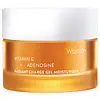What's inside
What's inside
 Key Ingredients
Key Ingredients

 Benefits
Benefits

 Concerns
Concerns

 Ingredients Side-by-side
Ingredients Side-by-side

Water
Skin ConditioningButylene Glycol
HumectantTrisiloxane
Skin ConditioningAmmonium Acryloyldimethyltaurate/Vp Copolymer
Trehalose
HumectantCyclopentasiloxane
Emollient3-O-Ethyl Ascorbic Acid
Skin ConditioningAllantoin
Skin ConditioningAdenosine
Skin ConditioningActinidia Polygama Fruit Extract
Skin ConditioningPhenoxyethanol
PreservativeAscorbic Acid
AntioxidantDimethicone
EmollientPolyglyceryl-3 Methylglucose Distearate
EmulsifyingPolysorbate 20
EmulsifyingDisodium EDTA
Ethylhexylglycerin
Skin ConditioningDimethicone/Vinyl Dimethicone Crosspolymer
Skin Conditioning1,2-Hexanediol
Skin ConditioningChondrus Crispus Powder
AbrasiveSynthetic Fluorphlogopite
Agar
MaskingAcrylates/C10-30 Alkyl Acrylate Crosspolymer
Emulsion StabilisingTromethamine
BufferingGellan Gum
Trideceth-9
EmulsifyingPEG-40 Hydrogenated Castor Oil
EmulsifyingParfum
MaskingSqualane
EmollientCI 77891
Cosmetic ColorantCI 77492
Cosmetic ColorantCI 19140
Cosmetic ColorantCI 14720
Cosmetic ColorantWater, Butylene Glycol, Trisiloxane, Ammonium Acryloyldimethyltaurate/Vp Copolymer, Trehalose, Cyclopentasiloxane, 3-O-Ethyl Ascorbic Acid, Allantoin, Adenosine, Actinidia Polygama Fruit Extract, Phenoxyethanol, Ascorbic Acid, Dimethicone, Polyglyceryl-3 Methylglucose Distearate, Polysorbate 20, Disodium EDTA, Ethylhexylglycerin, Dimethicone/Vinyl Dimethicone Crosspolymer, 1,2-Hexanediol, Chondrus Crispus Powder, Synthetic Fluorphlogopite, Agar, Acrylates/C10-30 Alkyl Acrylate Crosspolymer, Tromethamine, Gellan Gum, Trideceth-9, PEG-40 Hydrogenated Castor Oil, Parfum, Squalane, CI 77891, CI 77492, CI 19140, CI 14720
Water
Skin ConditioningNiacinamide
SmoothingButylene Glycol
HumectantC13-15 Alkane
SolventDicaprylyl Ether
EmollientPentylene Glycol
Skin ConditioningJojoba Esters
EmollientGlycerin
HumectantArachidyl Alcohol
EmollientAmmonium Acryloyldimethyltaurate/Vp Copolymer
Bisabolol
MaskingAlpha-Arbutin
AntioxidantActinidia Polygama Fruit Extract
Skin ConditioningTranexamoyl Dipeptide-23
BleachingLeontopodium Alpinum Extract
Skin ConditioningAllantoin
Skin ConditioningCeramide NP
Skin ConditioningPhenoxyethanol
PreservativePhenyl Trimethicone
Skin ConditioningChlorphenesin
AntimicrobialBehenyl Alcohol
EmollientArachidyl Glucoside
EmulsifyingXanthan Gum
EmulsifyingCaprylic/Capric Triglyceride
MaskingVinyl Dimethicone/Methicone Silsesquioxane Crosspolymer
Carbomer
Emulsion StabilisingDeoxyphytantriyl Palmitamide Mea
Skin ConditioningHydrogenated Lecithin
EmulsifyingCholesterol
EmollientPotassium Hydroxide
BufferingTocopherol
AntioxidantParfum
MaskingCitric Acid
BufferingPotassium Sorbate
PreservativeSodium Benzoate
Masking1,2-Hexanediol
Skin ConditioningCaprylyl Glycol
EmollientWater, Niacinamide, Butylene Glycol, C13-15 Alkane, Dicaprylyl Ether, Pentylene Glycol, Jojoba Esters, Glycerin, Arachidyl Alcohol, Ammonium Acryloyldimethyltaurate/Vp Copolymer, Bisabolol, Alpha-Arbutin, Actinidia Polygama Fruit Extract, Tranexamoyl Dipeptide-23, Leontopodium Alpinum Extract, Allantoin, Ceramide NP, Phenoxyethanol, Phenyl Trimethicone, Chlorphenesin, Behenyl Alcohol, Arachidyl Glucoside, Xanthan Gum, Caprylic/Capric Triglyceride, Vinyl Dimethicone/Methicone Silsesquioxane Crosspolymer, Carbomer, Deoxyphytantriyl Palmitamide Mea, Hydrogenated Lecithin, Cholesterol, Potassium Hydroxide, Tocopherol, Parfum, Citric Acid, Potassium Sorbate, Sodium Benzoate, 1,2-Hexanediol, Caprylyl Glycol
Ingredients Explained
These ingredients are found in both products.
Ingredients higher up in an ingredient list are typically present in a larger amount.
1,2-Hexanediol is a synthetic liquid and another multi-functional powerhouse.
It is a:
- Humectant, drawing moisture into the skin
- Emollient, helping to soften skin
- Solvent, dispersing and stabilizing formulas
- Preservative booster, enhancing the antimicrobial activity of other preservatives
We don't have a description for Actinidia Polygama Fruit Extract yet.
Allantoin is a soothing ingredient known for its protective and moisturizingg properties. Because of this, it is often added to products with strong active ingredients.
Studies show higher concentrations of this ingredient can promote wound healing.
Though it can be derived from the comfrey plant, allantoin is produced synthetically for cosmetic products to ensure purity.
Learn more about AllantoinAmmonium Acryloyldimethyltaurate/Vp Copolymer (let's call it AAVC for short) is a synthetically created polymer. It's used as a film-forming agent and used to thicken the consistency of products.
AAVC is able to increase the consistency and viscosity of products due to its large molecule size. It also prevents ingredients from separating.
Butylene Glycol (or BG) is used within cosmetic products for a few different reasons:
Overall, Butylene Glycol is a safe and well-rounded ingredient that works well with other ingredients.
Though this ingredient works well with most skin types, some people with sensitive skin may experience a reaction such as allergic rashes, closed comedones, or itchiness.
Learn more about Butylene GlycolParfum is a catch-all term for an ingredient or more that is used to give a scent to products.
Also called "fragrance", this ingredient can be a blend of hundreds of chemicals or plant oils. This means every product with "fragrance" or "parfum" in the ingredients list is a different mixture.
For instance, Habanolide is a proprietary trade name for a specific aroma chemical. When used as a fragrance ingredient in cosmetics, most aroma chemicals fall under the broad labeling category of “FRAGRANCE” or “PARFUM” according to EU and US regulations.
The term 'parfum' or 'fragrance' is not regulated in many countries. In many cases, it is up to the brand to define this term.
For instance, many brands choose to label themselves as "fragrance-free" because they are not using synthetic fragrances. However, their products may still contain ingredients such as essential oils that are considered a fragrance by INCI standards.
One example is Calendula flower extract. Calendula is an essential oil that still imparts a scent or 'fragrance'.
Depending on the blend, the ingredients in the mixture can cause allergies and sensitivities on the skin. Some ingredients that are known EU allergens include linalool and citronellol.
Parfum can also be used to mask or cover an unpleasant scent.
The bottom line is: not all fragrances/parfum/ingredients are created equally. If you are worried about fragrances, we recommend taking a closer look at an ingredient. And of course, we always recommend speaking with a professional.
Learn more about ParfumPhenoxyethanol is a preservative that has germicide, antimicrobial, and aromatic properties. Studies show that phenoxyethanol can prevent microbial growth. By itself, it has a scent that is similar to that of a rose.
It's often used in formulations along with Caprylyl Glycol to preserve the shelf life of products.
Water. It's the most common cosmetic ingredient of all. You'll usually see it at the top of ingredient lists, meaning that it makes up the largest part of the product.
So why is it so popular? Water most often acts as a solvent - this means that it helps dissolve other ingredients into the formulation.
You'll also recognize water as that liquid we all need to stay alive. If you see this, drink a glass of water. Stay hydrated!
Learn more about Water